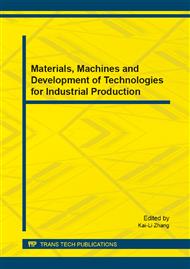[1]
S. Qian, H. H. Bau, Magneto-Hydrodynamics Based Micro-fluidics, Mech Res Commun. 2009, 10–21.
Google Scholar
[2]
M. Turkyilmazoglu, Heat and mass transfer of MHD second order slip flow, Computers & Fluids, 2013, 426–434.
DOI: 10.1016/j.compfluid.2012.11.011
Google Scholar
[3]
W. N. Mutuku-Njane1, O. D. Makinde, Combined Effect of Buoyancy Force and Navier Slip on MHD Flow of a Nanofluid over a Convectively Heated Vertical Porous Plate, The Scientific World Journal, 2013, 725643- 8.
DOI: 10.1155/2013/725643
Google Scholar
[4]
M. J. Martin, C. Cai, I. D. Boyd, Slip Flow in a Magneto-hydrodynamic Boundary Layer, 43rd AIAA Plasmadynamics and Lasers Conference 25 - 28 June, 2012, New Orleans, Louisiana.
DOI: 10.2514/6.2012-3295
Google Scholar
[5]
M. Turkyilmazoglu, Exact analytical solutions for heat and mass transfer of MHD slip flow in nanofluids, Chemical Engineering Science, 2012, 182–187.
DOI: 10.1016/j.ces.2012.08.029
Google Scholar
[6]
T. Fang , J. Zhang, S. Yao, Slip MHD viscous flow over a stretching sheet – An exact solution, Commun Nonlinear Sci Numer Simulat, 2009, 3731–3737.
DOI: 10.1016/j.cnsns.2009.02.012
Google Scholar
[7]
L Crane, Flow past a stretching plate, Z Angew Math Phys, 1970, 645–651.
Google Scholar
[8]
C. Y. Wang, Flow due to a stretching boundary with partial slips—an exact solution of the Navier–Stokes equations, Chem Eng Sci, 2002, 3745–3747.
DOI: 10.1016/s0009-2509(02)00267-1
Google Scholar
[9]
W. Ibrahim, B. Shankar, MHD boundary layer flow and heat transfer of a nano-fluid past a permeable stretching sheet with velocity, thermal and solutal slip boundary conditions, Nonlinear Analysis: Real World Applications, 2011, 1338–1346.
DOI: 10.1016/j.compfluid.2013.01.014
Google Scholar
[10]
K. Bhattacharyya, S. Mukhopadhyay, MHD Boundary Layer Slip Flow and Heat Transfer over a Flat Plate, Chin. Phys. Lett, 2011, 024701.
DOI: 10.1088/0256-307x/28/2/024701
Google Scholar
[11]
A.V. Lemoff, A.P. Lee, An AC magneto-hydrodynamic micro-pump, Sensors and Actuators B, 2000, 178–185.
Google Scholar
[12]
J. Jang, S.S. Lee, Theoretical and experimental study of MHD (magneto-hydrodynamic) micropump, Sensors and Actuators A, 2000, 84–89.
DOI: 10.1016/s0924-4247(99)00302-7
Google Scholar
[13]
M. Rivero, S. Cuevas, Analysis of the slip condition in magneto-hydrodynamic (MHD) micropumps, Sensors and Actuators B, 2012, 884– 892.
DOI: 10.1016/j.snb.2012.02.050
Google Scholar


